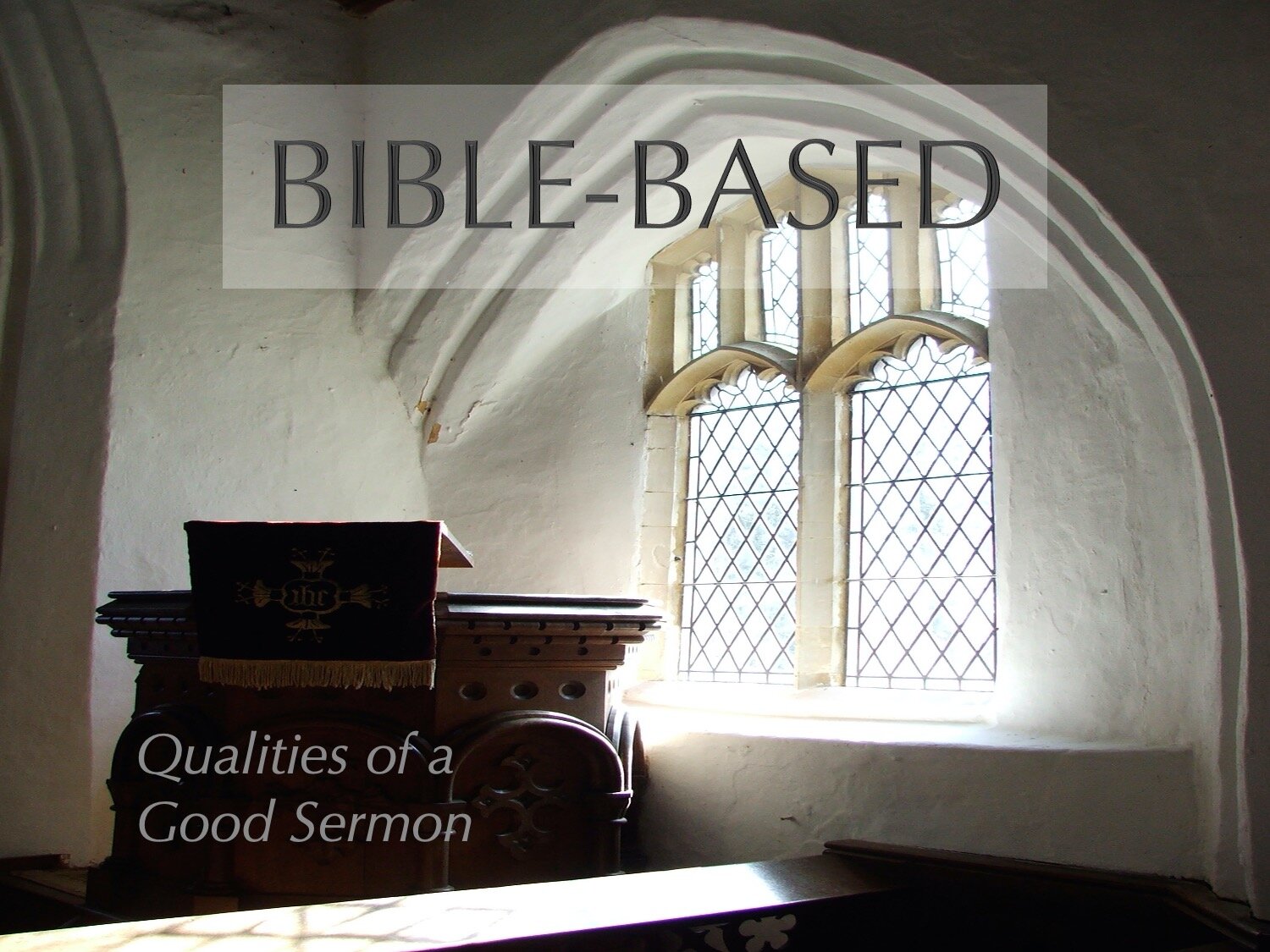
Bible-Based
Preaching God’s Message from God’s Word
Steps Toward Bible-Based Preaching
All preaching, if it is to be distinctly “Christian preaching,” should have the biblical text as its foundation. Why? Because, though the Bible is not the only way God has revealed himself, it is the clearest. It tells us the story of all he has done in history, from creation to new creation, with its climax in his ultimate revelation in the person and work of Jesus.
Like Jesus, the Bible is both fully human and fully divine — uniquely inspired by God’s Spirit, but also intimately tied to the experiences, the understanding and the concrete historical situations of God’s people in the past. Because it is fully divine, we must take it seriously and receive it as God’s word. Because it is also fully human, we must take our responsibility seriously — to study it, understand it, handle it accurately so that we may present it faithfully to God’s people in the present.
For all of these reasons, a preacher needs to have a sound process of studying the Scriptures, discerning truth, and traveling the path from the biblical text to the contemporary sermon. The posts and articles in this section are intended to help you on that journey.
Information is in ready supply, but you don’t really know a thing until you know it experientially. So it is with the Scriptures. If you want to know the text, you must examine the text for yourself.
All human need is rooted in the brokenness of creation brought on by sin. The purpose of the Scriptures is to point to God’s mission of redemption and restoration – the only real answer to our need.
You can’t truly address human need without pointing to God’s solution in the Scriptures. You can’t truly preach the Scriptures without applying them to the brokenness that is at the root of all human need.
Once you have done your own work on the text, there is real value in going to some trusted biblical commentaries to add the insights of others to your study. Here are three major purposes for this reference study, and some tips for doing it well.
How do we address the problem of words? This is an ongoing and daunting challenge for anyone who wishes to preach the Scriptures faithfully. As with any other challenge in our path from text to sermon, it helps to have a process. Such a process is the subject of this post. Here are eight steps I have found helpful.
I have suggested a path towards analyzing the “structure” of a biblical narrative by focusing on setting, characters, and plot. Let’s try this out by analyzing a story that you may have never considered preaching a sermon from – the sordid tale of Judah and Tamar in Genesis 38. Our tendency might be to pass this one by as too steamy for a general audience, and maybe not even that important. It appears oddly inserted in the middle of the Joseph story as something of a detour that may be best ignored. Think again. On careful analysis, it may be one of the most important stories in this part of Genesis.
I have described the basic structure of Hebrew poetry as built around parallel couplets and triplets that are ultimately grouped into larger strophes to provide the overall logic of the poem. An outline of a poem begins with analyzing the smallest units (parallel lines) and expanding to the larger units (groupings of couplets and triplets into “strophes”). As an example, let’s analyze Psalm 46.
Most biblical texts fall into one of three broad language categories: Prose, Poetry, or Story. Though they often overlap in many ways, each of these communicates, challenges, and shapes us differently. In fact, like the three modes of transportation to Australia, they give us such different journeys that the perspectives they give of the same truth might seem widely divergent, even when the destination is the same.
In your preparation process, these differences become impossible to ignore the moment you begin to try to outline the meaning of the text. Let’s think about each of these language categories specifically from the perspective of how we would outline the text.
True fishermen never stop looking for just the right combination of bait and technique to catch a fish in any given pond or stream. Lure, minnow, worms or stink bait? Spinner, jig, or fly? They study fish and habitats endlessly, to make the best possible choices, and increase their chances of catching the “big one.”
I’m no fisherman, but I think I understand their drive. As a preacher, I’m always looking for the “big one” — the big idea of a given passage. But each passage is unique, and it swims in a particular pond or stream. Different kinds of texts work differently and communicate their truths in distinctive ways. If I am to coax the right truth consistently out of every text, I must learn to read each text according to its own rules. Like a fisherman who never stops studying fish and habitats, a preacher must make a life-long endeavour of studying literary genres and forms.
Once you have chosen a text and gotten the big picture of the story around the text and the story behind the text, it’s time to have your own dialogue with the text. Resist the temptation to jump right into the verse by verse discussion in your favorite commentary, or listen to a sermon from your favorite preacher on the same passage. This will only give you second-hand information. You need to have your own conversation, your own encounter.
Politicians and marketers may deliberately take words out of context to serve their own purposes, but could preachers do the same thing? We should give one another the benefit of a doubt. We need not assume deliberately malicious intent. But we should acknowledge that we sometimes pluck words, phrases, and verses out of their context to make a point that we want to make, regardless of their actual meaning.
Here’s the good news: Ignoring the literary context of a passage may be the most frequently-committed exegetical error among preachers, but it is also the easiest to correct. Here are some steps you can take to get the context right.
Not knowing the story behind a text can be like walking blindly into the middle of a conversation. There’s a very good chance you could miss the meaning altogether. This is why we begin to gain an understanding the big picture of a biblical text by studying its historical context.
The temptation of any busy preacher is simply to listen to the voices of trusted guides (study helps, commentaries, other preachers, etc) in our journey from the biblical text to the sermon. In most cases, they can get us from “A” (the words of the text before us) to “B” (the meaning of the text before us) efficiently and accurately. However, our goal is not just to get from “A” to “B,” but to guide others in their own journeys from the text to its meaning, and to the demands, encouragement, and perspective it brings to their lives. For this, we need to know the terrain, to explore the lay of the land, to have the big picture.
Where do you begin your sermon preparation – with a contemporary need, or with a biblical text? This is a trick question, and you should not fall for it. Be careful neither to emphasize human need to the neglect of the text, nor to emphasize the text to the neglect of human need. To do the former is to wallow in a quagmire of questions with no real answers. To do the latter is to try to preach the Bible while missing the point of the Bible.
I used to have a cartoon clipping on my desk portraying the weekly evolution of a pastor. It was a chart, patterned after those old “evolution of man” illustrations. On Monday, the pastor was collapsed like a puddle on the floor. On Tuesday, he was crawling. Each day he progressed a bit more until Sunday, when he was erect, composed, dressed and in his right mind, ready to take on the world. Then, on Monday, he was a puddle again, and the whole thing started over.
If you’re like me, you’ve experienced those Mondays. The highs and lows of Sunday have left you physically, mentally, emotionally, and perhaps even spiritually depleted. I’m pretty sure Jeremiah wrote Lamentations on a Monday. A lot of preachers I know take Monday off, but I never did — just because I didn’t want to spend my day off feeling so worn out. Besides, taking Monday off just postpones the inevitable. Yesterday’s sermon is history, but Sunday is only six days away. Better to go ahead and get back to work.
Maybe your pastor, for a reason clear to him but a mystery to you, has asked you to preach. Or you are going on a mission trip, and every member of the team must be prepared to speak. Or you are the designated preacher for your family reunion. Or perhaps you are a new pastor, suddenly overwhelmed with the responsibility of preaching at least once each week.
Whatever the reason, you are faced with the daunting task of bringing a word from God to the people of God. Where do you begin?
No evangelical preacher I know would think of making a list of “qualities of a good sermon” without including “Biblical” at or near the top of the list. But what do we mean when we say the sermon should be biblical? We may not have such a ready answer for that one!
What would make your list of qualities of a good sermon? For some, the priority is on the substance of the message. Others recognize that it doesn’t matter what you intend to say if you can’t say it clearly enough for the message to be understood. For others, interest is paramount — whatever the sermon is, it should not be boring!
Which perspective is correct? Like many either-or questions, the answer is “yes!” All of the above! So, here is my current list …

















Once you have studied the literary and historical context of the passage, considered its genre and form, analyzed its structure, defined its words, and verified your findings through some good research, you are ready to summarize your conclusions in some straightforward statements about the text’s meaning in its original setting.